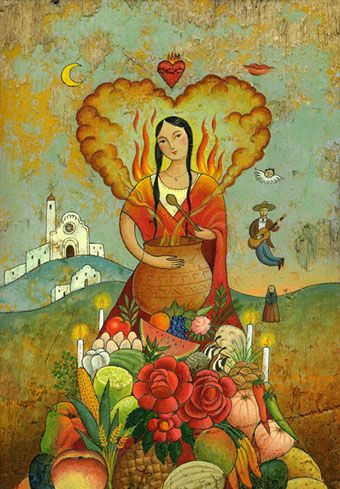Chocolate, Witches, & Magic Sex: What You Sipping On?
Chocolate, Witches, & Magic Sex: What You Sipping On?
Know what turns us on?
Hot chocolate sex hex. Yes please!
Witches, spells, and steaming cocoa: All the Fairy Tale elements of a great bedtime story. Did we mention it might be laced with pubic hair? Yeah, spice so smoking it’s on fire.
Read between the lines — turns out the Spanish Inquisition was kinda hot.
Under the strict darkness of Guatemalan Catholicism in the 1600s, the Spanish colonial government in Latin America tried countless women on charges of witchcraft — or more specifically practicing magic through bewitched hot chocolate, AKA chocolate-related brujería, or witchcraft.
The story checks out — if you’ve ever tried a steaming cup of Mexican hot cocoa in Oakland’s Fruitvale district: sizzling, like a ‘64 Impala Hi-riser, pumping purple Polka rims.

Chocolate Witchcraft?
Chocolate was a potent drink cultivated in the Americas for at least 3,000 years, as common as a cup of morning Joe and fruit danish. Hot chocolate was shared by couples in marriage ceremonies, used as an aphrodisiac — and more often than not, magic spell inducer, especially for sex and romance. Chocolate was thought to be the blood, the essence and vitality of life. Aztec Emperor Moctezuma reportedly drank chocolate “for success with the women,” and women drank it for rejuvenation during childbirth and menopause.
In 16th Century Spanish Colonialism, hot chocolate was medicinal — mind-openly potent, genital and inspirational. “(Women) shared recipes for homemade cures, which blurred the boundaries between what we’d now call science and magic, and they often consulted Indigenous healers,” writes Reina Gattuso in Atlas Obscura.
Chocula Healing
In Indigenous Latin America, healing was women’s work. (Let’s be real — it pretty much still is, universally. Thank God for women.) Witchcraft accusations served to control Indigenous women who frequently threatened the emerging European power structure and male control. Fears of witchcraft and powerful females subjected women to the threat of the Spanish Inquisition, punishable by prison or even death.
And since hot chocolate had Indigenous origins, was made and served by women, spellbinding hot cocoa — and fears of poisoning — scared men out of their willies, literally.
Juan de Fuentes approached the Inquisition and accused his wife Cecilia of bewitching his masculinity through “Satanic” hot chocolate. The 33-year-old mixed-race construction worker just couldn’t get it up anymore. And he felt strangely compelled to serve his woman breakfast in bed, proof of the Devil in the Bitches Brew. “All this cannot be a natural thing,” the court ruled and sentenced Cecilia to jail.
Hot cocoa so mind-blowingly yummy you serve her in bed?
Taking our cue from the B-52’s: “Glitter on the mattress, glitter on the front porch, Love Shack, baby, everybody’s moving, everybody’s groovin’….”

Voodoo vs. the Spanish Inquisition
The Inquisition’s crackdown on witchcraft and spellbinding hot cocoa was part of a larger effort to stamp out Indigeneous traditions. Making up only 15% of the population of Colonial Latin America, Europeans felt threatened. They instituted curfews and laws prohibiting people of African descent from wearing jewelry or dressing like Indigenous people. Under the authority of the church, Europeans policed Latin American society in a vain attempt to stamp out anything Native. Traditional ways were deemed the work of Satan.
Basically, they wanted to make Latin America as Puritan as white bread, Lawrence Welk, and sock suspenders. How’s that working out?
Dear John (Paul, George, Ringo, Pope Francis Your Holiness)
Maybe we should send the Catholic Church a breakup note (or a salty love letter, left beside a steaming cup of menstrual chocolate: “Your Holiness, prepare thyself to blush….”)
In its effort to stamp out and extinguish Witchcraft and Indigenous folklore traditions, the Inquisition pushed marginalized communities to the shadows. And that’s where the party truly began — and continues today.
The Inquisition effectively created “an interaction of people and beliefs…that proved a fertile ground for the flowering of a popular magical and religious culture beyond [the Inquisition’s] control,” writes Cuban-American anthropologist Ruth Behar in “Sex and Sin, Witchcraft and the Devil in Late-Colonial Mexico.”
Hell yeah, the best parties rock underground: why John Lennon is more popular than Jesus, why Russian teens wear blue jeans and listen to the Beatles, why witches spin vinyl thick with funk sauce.
Brujería Hip Hop Witches
Brujería magic has become an incantation for modern Feminists from Oakland to New York to Puerto Rico and beyond. Today, Bruja Feminism is celebrated in music and dance, in literature and Hip-hop. Afro-Puerto Rican rapper Princess Nokia pays homage to the tradition on her track “Brujas,” rapping:
“I’m that Black Native American, I vanquish all evil
I’m the Black a-Rican bruja straight out from the Yoruba
And my ancestors Nigerian, my grandmas was brujas.”
Similarly, the Oakland-based female vinyl club B-Side Brujas celebrate this tradition of folklore mysticism with a modern funky bass line. Featuring the DJ beats of Moe Alvarez, Dharma Mooney-Haynes, April Garcia, and Zakiya Mowat, the group spins soul, oldies, cumbias, and funk. They celebrate unity in diversity, the healing power in community, and often give ritual blessings before their sets.
There’s even a New York-based Skate Crew — the Brujas — that organizes female-empowered community events that are gender-inclusive for youth.
Whatever it is — Lawrence Welk it ain’t.

Voodoo Herbs (Slight Return)
At Bear Blend, we love us a steaming cup of hot cocoa Feminism, bewitched ‘til we twitch. The Brujería tradition blends the best in herbal folklore, the incantation of nature and the celebration of the elemental syllable. Like we said, yes, please!
Mixing our organic herbs, we like to fancy ourselves witches, using the magical, healing power of nature to blend medicinal creations to make life better — and sexier.
Many of our blends promote vitality. Damiana, a heady ingredient in many Bear Blends, is a flavorful desert herb the Mayans brewed as a tea for sexual invigoration. Yerba Mate, a powerful herb used to inspire energy, is rich in Theobromine, the happy ingredient in chocolate. Mugwort, a dreamy herb, promotes energy and vivacity.
Like a piping cup of bewitched hot cocoa, Bear Blend can bring the Yin to your Yang, rejuvenate your pants, turn on the essence of life — maybe even inspire you to serve your witch, wizard or sorceress breakfast in bed.

Mathew Gallagher
Wordsmith Specialist
A freelance writer for hire, Matt Gallagher is the face and voice behind Web Copy Magician. He enjoys Bear Blend as a tea to spiritually reconnect with nature and the therapeutic wonders of chlorophyll.
Join the Bear Blend Tribe
Tribe members receive special discounts on products, invitations to premier events and are welcomed to contribute writings and videos to the community.

0 Comments
Trackbacks/Pingbacks